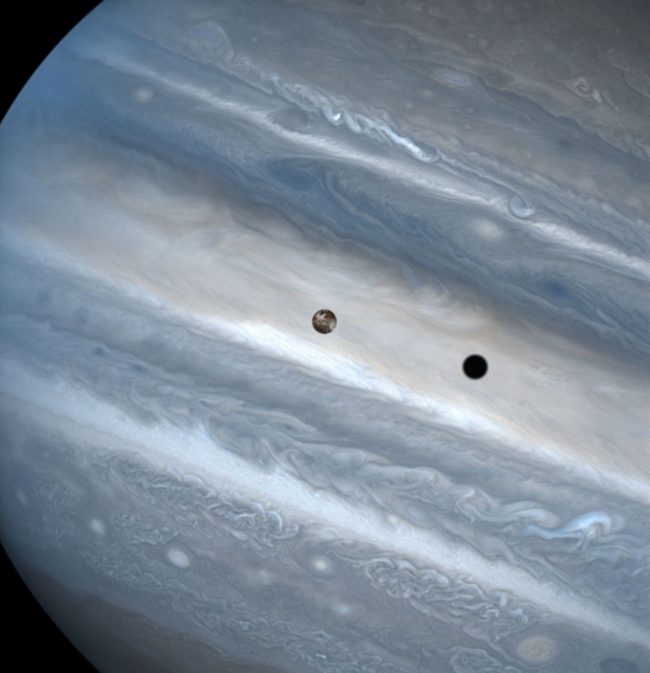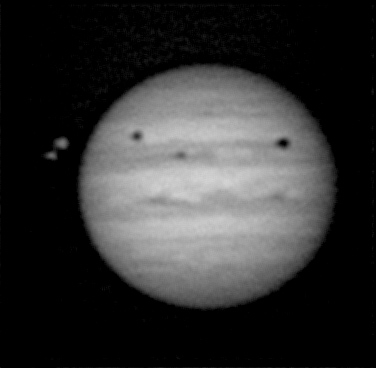
Transits of Jupiter’s moons
Astronomers speak of a transit of when one of Jupiter’s four large Galilean moons, or its shadow, crosses in front of the giant planet. These transits are interesting and dynamic. They’re predicted well in advance. You’ll need powerful binoculars or a 2- to 3-inch (60 mm) telescope to see a transit. But once you have the right equipment, and you’ve trained your eye to see, you only need to look at Jupiter at the right time. You’ll see a moon in transit crossing Jupiter’s banded face. Or you’ll see a tiny dark speck – a moon shadow – crossing Jupiter. Transits by a moon or its shadow happen regularly. There are 612 events in 2021 alone! On August 15, 2021, we’ll have a rare triple transit of Jupiter’s moons. More about the August 15 event below.
Here’s why you need to train your eye. The light and color of the four large Galilean moons blend in well with the light and color of Jupiter itself. The moons can be a challenge to see in front of Jupiter. Moon shadows are easier to see on Jupiter because they present a dark point on a bright background. And here’s subtle effect you’ll notice when one of the Galilean moons passes in front of Jupiter. The little moon will “disappear” from the darkness beside Jupiter, just as it begins to cross in front of the planet.
Check out the stunning image shared by @JLucDauvergne on Twitter. His photo shows both Io and its shadow transiting Jupiter. The giant dark scar on Io marks Prometheus, an active volcano on Io.
Here is the final image of Jupiter. It's not done with my Mewlon 300, but with a Cassegrain 350/6835 mm that I'm testing. I think that it is the best image ever from my balcony. Look at the dark spot in the middle of Io, it's volcano Prometheus! pic.twitter.com/edMV0UPaUB
— Skywalker (@JLucDauvergne) July 22, 2021
Double shadow transits
If it’s exciting to see the dark shadow of a moon crossing Jupiter, it’s even more thrilling to see two shadows crossing the planet at once! The two shadows that appear on Jupiter’s surface together most frequently are Io and Europa, the two moons closest to the planet.
Most of 2021’s upcoming double shadow transits are not favorable for North American observers, happening in daylight or after Jupiter has set below our horizon. For other areas of the globe, you might want to check out some of the following dates and times of double shadow transits on Jupiter for the month of August, and see if any of them occur in darkness when Jupiter is visible for you. The times are in Coordinated Universal Time (UTC). Translate UTC to your time zone.
A couple of chances to catch transits arrive for parts of North America in October 2021. The first is overnight from October 18-19. On October 19 at 1:12 a.m. CDT, Io’s shadow will appear on one limb of Jupiter, joining Ganymede’s shadow, which has already been passing in front of the planet and is now on the opposite side of Jupiter. The pair of shadows will only be together on Jupiter’s surface for about 18 minutes before Ganymede’s shadow slides off. This event occurs just before Jupiter sets (around 1:50 a.m.), so you will need a flat, unobstructed horizon to the south-southwest.
On the West Coast, this double shadow transit will occur on October 18 at 11:12 p.m. PDT. Jupiter will be higher above the horizon then, affording observers a better view. For observers along the U.S. East Coast, the event basically starts at the same time as Jupiter sets, just after 2 a.m. on October 19.
The next double shadow transit occurs on October 26 after Jupiter has set for much of the U.S. East. The West Coast can see Io and Ganymede’s shadows again sharing the stage on Jupiter from about 1:08 a.m. PDT until Jupiter sets around 1:44 a.m. Hawaii will be a better place to watch this event, as it takes place on the evening of the night before, October 25, and the entire two-plus-hour transit of the shadows is visible while Jupiter is far above the horizon.
Once you get used to watching the moons’ shadows, you’ll be able to identify which satellite is casting its shadow on the moon by their distinctive differences. Ganymede’s will be large (relatively speaking) like the giant moon that it is. Io will be more of a “period,” and little Europa will be the smallest of all. Callisto, the farthest moon from the planet, will project a grayer, diffuse-edged shadow.

Triple transits on Jupiter
The three inner satellites of Jupiter – Io, Europa and Ganymede – are locked in an orbital resonance as a result of the tidal effects of giant Jupiter. The resonance between the three moons is described as 1:2:4, which means that for every one orbit that Ganymede completes, Europa completes two orbits and Io swings around Jupiter four times.
Watch this unique video that shows the 1:2:4 resonance of the moons and assigns a different sound to each moon once they complete an orbit from the top. The orbits are gradually sped up so you can hear the beat more easily.
Because of the way that these three moons are tidally locked into specific orbits, they can never all be in front of (or behind) Jupiter at the same time. So any transit event that occurs with three of the Galilean moons must necessarily include the most distant Callisto. And Callisto is not always at the correct angle for us to see transits or eclipses every time it circles Jupiter. Every six years, lasting for about three years, the farthest Galilean moon is in position to allow us a chance to see a triple transit event. A triple transit event involves three of the Galilean moons or shadows transiting the face of Jupiter at the same time as seen from Earth.
August 15, 2021, triple transit
Before 2021, the last triple transit event was in 2015. The next will be August 15, 2021! And the next such event won’t be until 2025. A triple transit of only shadows on Jupiter is rarer, with the last in 2015 and the next in 2032.
The August 15 event will begin around 15:17 UTC. At this time, Callisto will be in front of Jupiter while both Ganymede and its shadow are also in front of Jupiter. The triple event begins when Europa’s shadow edges onto the planet’s surface, thus Callisto, Ganymede and Europa are all transiting the planet whether by their actual satellite or the satellite’s shadow.
At the beginning of the transit you can still spot Io off to one side of Jupiter (the side that Callisto is on) while Europa is off to the other side of the planet in front of the blackness of space. But it won’t stay there. By 15:20 UTC, Europa itself will join its shadow and the other two planets in front of Jupiter. Then, around 15:42 UTC, Io disappears behind Jupiter, leaving no specks of light from Jupiter’s moons to be seen around the planet. The triple transit event ends soon after, as Callisto edges off the planet and back in front of dark space by 15:54 UTC.
Now for the bad news. Because Jupiter is not always above the horizon, or for some it’s above the horizon in daylight, not everyone gets to see this rare event. Only observers in parts of Australia and Asia will get a glimpse. For example, in Kuala Lumpur, Malaysia, the event begins on August 15 at 11:17 p.m., while in Sydney, Australia, the event begins on August 16 at 1:17 a.m.
As a bonus to the observers on this night, if you keep observing after the triple transit event is over, you’ll get to see the quicker Europa pass under Ganymede, so that it will appear that the two moons temporarily merge, along with their shadows!

Bottom line: When a moon or the shadow of a moon passes in front of Jupiter from our perspective, it’s called a transit. Shadow transits are easier to see because of the darkness against the bright planet. Double shadow transits occasionally allow observers to see two shadows on Jupiter at once, and a rare triple transit involving two shadows and a moon (actually two moons) will occur on August 15.











